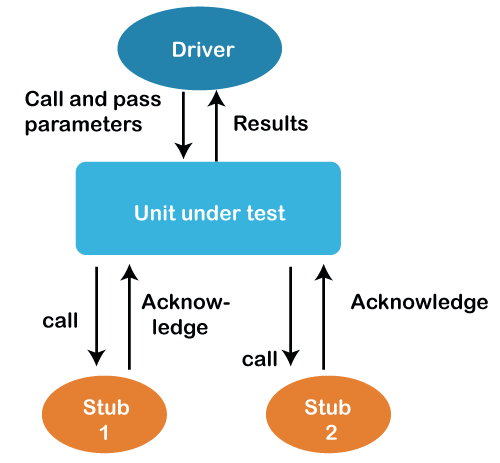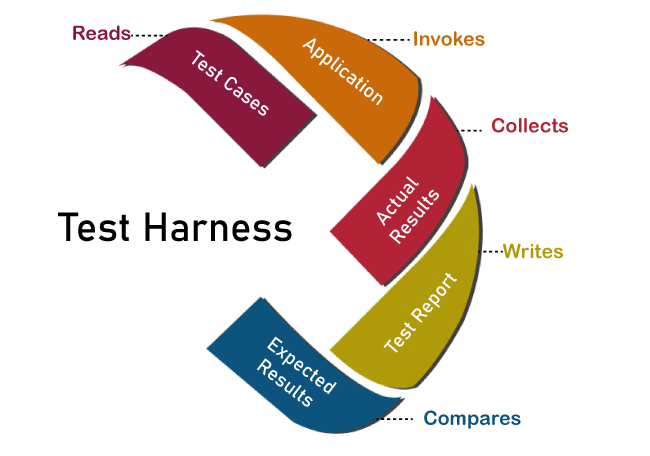What is Test Harness?Test Harness is a collection of stubs, drivers, and other supporting tools required to automate test execution. Test Harness executes a test by using the library and generates reports. Test Harness tools include Junit, Nunit, PyTest, etc. A Test Harness or automated test framework is a collection of software and test data configured to test a program unit by running it under varying conditions and monitoring its behaviour and outputs. In addition to developing the test cases, supporting code must be developed to exercise each unit and to connect it to the outside world. Target UnitSince the tester is considering a stand-alone function/procedure/class rather than a complete system, code will be needed to call the target unit and represent modules that the target unit calls. So, this code, called a test harness, is developed especially for tests and is in addition to the code that composes the system under development.
For example, a driver could have the following options and combinations of options:
The stubs could also exhibit different levels of functionality. For example, a stub could: 
The test planner must realize that the higher the degree of functionality for the harness, the more resources it will require to design, implement, and test. Depending on the nature of the code under test, developers or testers must decide just how complex the test harness needs to be. Objectives of Test HarnessThe main goals of the test harness are to:
Features of Test Harness
Role of Test Harness system in Automation and Integration TestingAutomation TestingThe test harness system plays an important role in the automation testing of applications. It will offer test scripts written in programming languages like Java, Python, Ruby, etc., and the test data to perform the testing using the test scripts. It will also help the developers to gather the results of each test case with enhanced charts and reports for the test results, which will support development teams in comparing the actual and expected data. Integration TestingFor performing an integration test, the code of all modules should be ready to complete the test. So, it is not possible in real-life scenarios, as most of the time, other modules of the application need to be developed. A test harness system will provide stubs and drivers, substitute codes used in place of the underdeveloped module. With the test harness system in integration testing, it is possible to ensure that all modules involved will operate as a successful unit for each test case. Significance of Test Harness in Software TestingThe test harness system will help the QA teams to choose the correct way suitable for the app testing before performing the testing of any application. It will enable development teams to estimate the code coverage in the early stages of software testing. By using a test harness system, QA experts will automate the entire testing process and hence increase the overall productivity of the software testing cycle. The test harness system is useful for managing difficult conditions, like communication with various libraries and complicated tasks for testers. Test Harness vs. Test FrameworkTest Harness is similar to, but not the same, testing frameworks. While test harnesses are the collection of software and test data used to test a program, test frameworks are the set of processes and procedures through which automated tests are designed and implemented. Test harnesses are used in automated testing and integration testing. However, test frameworks can be used in multiple scenarios, such as data-driven, behaviour-driven, and keyword tests. Test frameworks also require information such as a test library, testing software, and a testing platform. Examples of Test Harness ToolsThere are two important tools used in test harness systems. They are:
JUnitJUnit is an open-source framework in the Java language. It is used to develop and perform automated test cases. Specifically, it is used to execute the unit testing of the Java program or the applications written in the Java language. NUnitLike JUnit, NUnit is also an open-source framework, but it is written in the .NET language. NUnit is used to develop and perform automated test cases. Moreover, it is mainly used in test-driven development (TDD). Integrate HeadSpin with Test Harness Tools for Effective Software TestingAs the main objective of using a test harness tool is to automate testing and improve test efficiency, HeadSpin is the best tool for QA teams to double the benefits of a test harness tool. With a focus on helping global enterprises to optimize and automate their testing procedures, HeadSpin offers a centralized testing platform with unique capabilities, including automated functional, performance, and load testing across applications, devices, and networks for mobile, web, IoT, and 5G. Let's check some of the best-in-class features of the HeadSpin Platform that will help QA teams boost the advantages of test harness systems and overall test efficiency. 1. Data Science and AI Capabilities for Effective Software TestingUsing the data science capabilities of the HeadSpin Platform, QA teams can gather a large set of data about the software being tested. Also, they can collect secondary metrics, such as packet, code, and network visibility details, page load time, API, CDN, and third-party SDKs. At the same time, QA teams can use HeadSpin's AI engine to pinpoint the possible errors a user can face and resolve them proactively. HeadSpin's data science and AI capabilities can support global enterprises in improving their testing efficiency. 2. End-to-End Automation TestingWith the HeadSpin Platform, global companies can execute end-to-end automated testing of software applications. QA teams can get end-to-end visibility and UX and functional assessments using the Platform. HeadSpin's end-to-end automatic testing feature can support organizations to increase and improve collaboration while using test harness tools across teams and team members. Moreover, with HeadSpin automation capabilities, global enterprises can enhance their test efficiency and coverage. Global Device InfrastructureHeadSpin maintains a global infrastructure of various devices, including mobile and desktop browsers, smart TVs, OTT devices, game consoles, and more, deployed across 90+ locations worldwide. With the help of the HeadSpin Platform, enterprises get access to thousands of real mobile and browser testing devices to execute testing of websites, native apps, and hybrid applications from various geographies. Advantages of the Test Harness SystemLet's check some of the test harness system's advantages that support software development and testing. 
Automation of the Testing Process A test harness system supports QA teams in automating the overall testing process to the maximum extent. The execution engine is the main component of a test harness system. The execution engine is the automated system in a test harness system that performs all testing activities with the test scripts. With the automation of the testing process, a test harness system helps QA teams to shorten the testing cycle. Collection of Test Scripts for Various Test Cases The test repository in the test harness system contains test scripts for all test cases planned to be executed. This system component enables QA teams to execute test suites composed of multiple test cases. A test harness system also contains drivers and stubs, which are small programs capable of supporting code debugging, even if some application components are under development. Generation of Detailed Test Reports A test harness system helps development teams generate test reports through its system or through TestNG and other third-party tools. Development teams can access a detailed report about the testing cycle and processes involved, and this report will help them to improve their development methods with effective steps.
Next TopicSpeech on Time Management
|
 For Videos Join Our Youtube Channel: Join Now
For Videos Join Our Youtube Channel: Join Now
Feedback
- Send your Feedback to [email protected]
Help Others, Please Share









